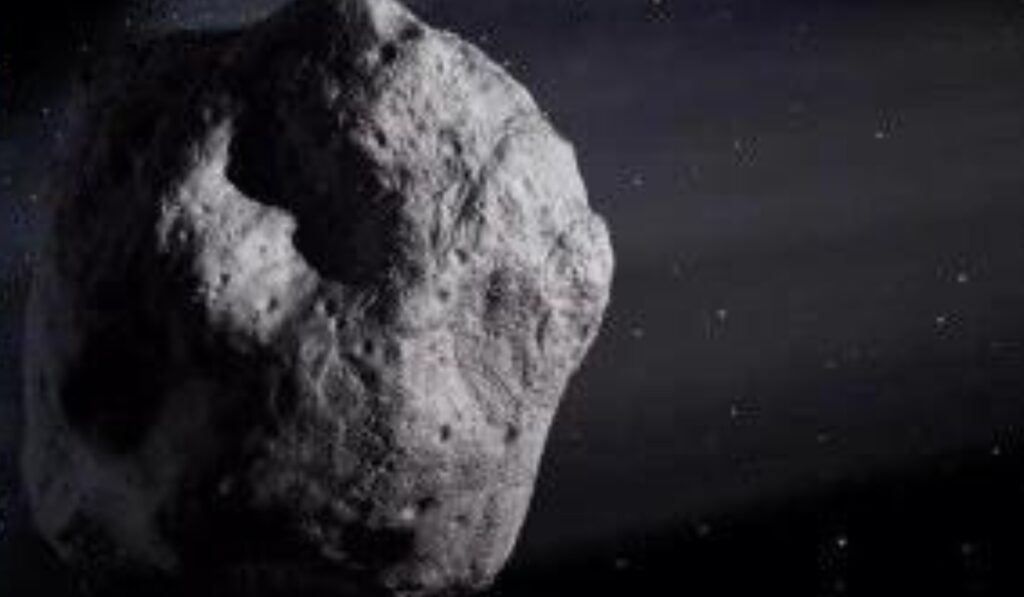In roughly five years, the Earth will witness a dramatic celestial encounter. Apophis, a near-Earth asteroid, will hurtle past our planet at an unnervingly close distance of just 20,000 miles (32,000 kilometers) – a hair’s breadth in astronomical terms.
This close shave presents a golden opportunity for scientific exploration, and researchers around the globe are gearing up for a grand unveiling of Apophis’ secrets.
Apophis measures 340 metres across– comparable to the size of the huge ship that blocked the Suez Canal.
From Menace to Muse: A Reassuring Reclassification
Discovered in 2004, Apophis initially sent shivers down spines worldwide. Its size – a staggering 1,100 feet (335 meters) in diameter – and initial trajectory sparked fears of a future impact event. Fortunately, meticulous observations by astronomers around the world have since alleviated these anxieties. Scientists have definitively ruled out any possibility of Apophis colliding with Earth for at least the next century. This reassuring news transformed Apophis from a potential planetary threat into a captivating celestial muse.
A Once-in-a-Lifetime Examination: Probing Apophis’ Composition and Internal Dynamics
The upcoming flyby presents a unique opportunity to delve into the mysteries of Apophis’ physical makeup and internal dynamics. By studying the asteroid before, during, and after its close encounter with Earth, scientists hope to glean valuable insights into its composition, spin, and orientation. Earth’s gravitational pull, though immense, might exert a subtle influence on Apophis, potentially triggering internal shifts in the distribution of its material or even altering its surface features. By meticulously tracking these potential changes, researchers can gain a deeper understanding of how a planet’s gravity interacts with celestial bodies. This knowledge is crucial for refining our models of asteroid deflection techniques, should a future space rock ever pose a genuine threat.
A Symphony of Innovation: Public and Private Collaboration to Expand Our Reach
The scientific community is not alone in its pursuit of Apophis’ secrets. Private space companies like Blue Origin and ExLabs are proposing daring missions to rendezvous with the asteroid, adding a dimension of private enterprise to this global endeavor. Blue Origin envisions leveraging its cutting-edge Blue Ring orbital platform to deliver scientific payloads directly to Apophis, facilitating low-cost, low-risk exploration missions. ExLabs, on the other hand, has proposed a mission called DROID (Distributed Radar Observations of Interior Distributions). This ambitious project would deploy a spacecraft equipped with CubeSats to perform a virtual “CAT scan” of Apophis’ interior, revealing its hidden structure and composition for the first time.
Repurposing and Reprioritizing: NASA’s Multi-pronged Approach to Unveiling Apophis
NASA is also heavily invested in unraveling Apophis’ mysteries. The agency’s OSIRIS-APEX spacecraft, having completed its mission to the Bennu asteroid, is now set to embark on a new adventure. After dropping off Bennu samples on Earth, it will undergo a course correction, performing a series of maneuvers, including close solar flybys and Earth gravity assists, to reach Apophis in 2029. This mission will provide invaluable data on the asteroid’s composition and surface features throughout the encounter. Additionally, NASA possesses a pair of spacecraft originally intended for the Janus mission. While a technical glitch delayed their initial targets, these probes might be repurposed to study Apophis instead, offering valuable data from a different perspective.
Looking to the Future: A Stepping Stone to Unraveling the Solar System’s Secrets
The upcoming encounter with Apophis is a testament to the power of international collaboration. Public and private entities around the world are pooling their resources and expertise to unlock the secrets of this celestial visitor. With more missions likely to be announced in the coming years, the scientific community is poised to gather an unprecedented wealth of data during this rare celestial encounter. Apophis’ 2029 flyby is not just a brush with a giant rock; it’s a chance to peer into the heart of an asteroid and expand our understanding of the building blocks of our solar system.

This newfound knowledge will not only shed light on Apophis itself but also provide valuable insights into the formation and evolution of asteroids in general, offering a glimpse into the very origins of our cosmic neighborhood. As we train our instruments on Apophis, we inch closer to unraveling the grand narrative of our solar system’s formation and evolution.



















